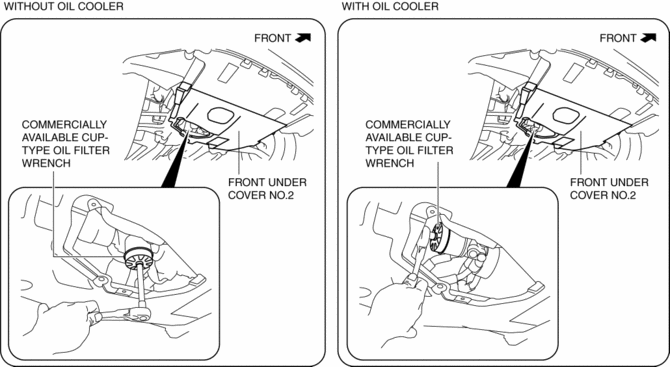Mazda CX-5 Service & Repair Manual: Oil Filter Replacement
WARNING:
-
Hot engines and engine oil can cause severe burns. Turn off the engine and wait until it and the engine oil have cooled.
-
A vehicle that is lifted but not securely supported on safety stands is dangerous. It can slip or fall, causing death or serious injury. Never work around or under a lifted vehicle if it is not securely supported on safety stands.
-
Continuous exposure to USED engine oil has caused skin cancer in laboratory mice. Protect your skin by washing with soap and water immediately after working with engine oil.
CAUTION:
-
If engine oil is spilled on the exhaust system, wipe it off completely. If you fail to wipe the spilled engine oil, it will produce fumes because of the heat.
1. Remove the service hole cover (installed to front under cover No.2) used to remove the oil filter.

2. Remove the oil filter using the commercially available, cup-type oil filter wrench (67 mm {2.6 in} diameter, 14 sided
).

3. Use a clean rag to wipe off the mounting surface.
4. Apply clean engine oil to the O-ring of a new oil filter.
5. Tighten the oil filter according to the instructions on the package or side of the oil filter.
-
Tightening torque (reference value)
-
12—16 N·m {123—163 kgf·cm, 107—141 in·lbf}
6. Start the engine and confirm that there is no oil leakage.
-
If there is oil leakage, repair or replace the applicable part.
7. Inspect the oil level..
8. Install the service hole cover.
 Oil Cooler
Oil Cooler
Purpose, Function
The oil cooler routes engine oil and engine coolant through the interior
and disperses the engine oil heat using the engine coolant. As a result, the
oil temperature is ...
 Oil Filter
Oil Filter
Purpose, Function
Engine oil is filtered by passing engine oil through the oil filter element.
Construction
The oil filter is installed on the right side surface of the cylinder bl ...
Other materials:
Power Window Subswitch Removal/Installation
1. Disconnect the negative battery cable..
2. Remove the cover A.
3. Insert a tape-wrapped fastener remover shown in the figure and remove the
tab B in the direction of arrow (1).
4. Slide the power window subswitch cover in the direction of the arrow (2) shown
in the figure and re ...
Seat Warmer Unit Inspection
WARNING:
Handling a side air bag improperly can accidentally operate (deploy) the
air bag, which may seriously injure you. Read the service warnings/cautions
in the Workshop Manual before handling the front seat (side air bag integrated)..
CAUTION:
If the slide bar is ope ...
Engine Front Cover
Purpose, Function
The engine front cover covers the front of the engine to prevent engine oil
spillage, noise leakage, and foreign material penetration.
Construction
The engine front cover is installed to the front of the engine.
The lightweight engine front ...
